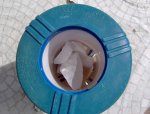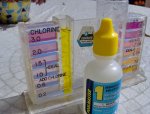I just refurbished my spa by tiling over the plaster/concrete. I have had the spa for years and prior to tiling, I may not have had any problems using tablets of chlorine, as I just put a 3" tablet in the skimmer.
When I refurbished the spa, I did extensive research about chemicals and have been reading this forum in particular and it appears that putting the tablet in the simmer may be a bad idea. So, I have been using a small float to chlorinate the spa.
I read on this forum that the best solution would be to use liquid chlorine bleach. However, because I have always used 3" tablets in the past and was running out of tablets, I bought 50 pounds because the price was lower to buy a larger quantity. So, now I need to use them up.
The problem I am having with the float is that when I put it in the spa, the following day the spa test shows that it is over chlorinated. Therefore, the next day I have to take it out and wait a few days for the chlorine levels to fall and then I put it back in the spa... and endless cycle.
I have reduced the cracks in the float to the smallest limit, but does not help.
I am using a small spa size float, but the 3" tablet do not fit so, I cut the tablets into smaller pieces. This may be one of my problem because of the surface area may be increased on the tablets, but I really do not think so. However, if that is the problem, I can buy a larger float and not cut up the tablets.
I am not sure it would be a good idea, but I can try putting the 3” tablets in the skimmer again, but I have read that is not a good idea and I am not sure it that will solve my issue, as until now I did not know I had a problem and I may have had this problem for years. Until now, I did not test as much and the testing reagents I was using may have been old. Now, I am using new reagents.
So, I am not sure what I should do now, as I do not want to through away 50 pounds of tablets and use bleach.
Thank you in advance for a suggested solution.
When I refurbished the spa, I did extensive research about chemicals and have been reading this forum in particular and it appears that putting the tablet in the simmer may be a bad idea. So, I have been using a small float to chlorinate the spa.
I read on this forum that the best solution would be to use liquid chlorine bleach. However, because I have always used 3" tablets in the past and was running out of tablets, I bought 50 pounds because the price was lower to buy a larger quantity. So, now I need to use them up.
The problem I am having with the float is that when I put it in the spa, the following day the spa test shows that it is over chlorinated. Therefore, the next day I have to take it out and wait a few days for the chlorine levels to fall and then I put it back in the spa... and endless cycle.
I have reduced the cracks in the float to the smallest limit, but does not help.
I am using a small spa size float, but the 3" tablet do not fit so, I cut the tablets into smaller pieces. This may be one of my problem because of the surface area may be increased on the tablets, but I really do not think so. However, if that is the problem, I can buy a larger float and not cut up the tablets.
I am not sure it would be a good idea, but I can try putting the 3” tablets in the skimmer again, but I have read that is not a good idea and I am not sure it that will solve my issue, as until now I did not know I had a problem and I may have had this problem for years. Until now, I did not test as much and the testing reagents I was using may have been old. Now, I am using new reagents.
So, I am not sure what I should do now, as I do not want to through away 50 pounds of tablets and use bleach.
Thank you in advance for a suggested solution.




 Welcome to TFP!!!
Welcome to TFP!!!